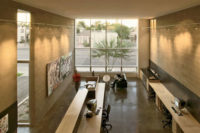Sunrise Mountain Library
















Peoria, Arizona
In the political realm, Phoenix generally toes the conservative line. Fortunately, when it comes to civic architecture, the city takes a more progressive stance. A case in point: In 1995, residents celebrated the opening of Will Bruder’s colossal Burton Barr Central Library, which quickly earned icon status in the Valley of the Sun. In the following years, as Phoenix expanded at breakneck speed, prominent Southwest architects were tapped to design a string of branch libraries, many of which have appeared in Architectural Record.
The Sunrise Mountain Library, conceived by the local firm Richärd + Bauer and finished in 2009, marks yet another example of the city’s willingness to embrace singular architecture. Constructed for $7.7 million, the 22,000-square-foot building rises from a partly developed swath of land in Peoria, a municipality in northwestern Phoenix. Surrounded by rows of bland, beige homes, the library adds some much-needed pep to a suburban neighborhood.
This is familiar territory for Richärd + Bauer. In addition to the Sunrise project, the 14-member practice has designed four other libraries on its home turf, including Desert Broom Library [RECORD, January 2006, page 96] and Arabian Library [RECORD, June 2008, page 96]. The firm, paired with Haydon Building Corp, won the Sunrise commission in February 2006. “We were rooting for them from day one,” says David Hunenberg, Peoria’s library manager. “Our residents had put up with a branch library in a high school for 10 years, and we thought they deserved the very best.”
The design team was handed a blank slate: a flat, 4-acre dirt lot in a sprawling development still in the blueprint phase. A park was planned for a site bordering the library. In terms of existing reference points, the architects didn’t have much to work with. “We were faced with this denuded piece of desert,” explains James Richärd, firm principal. Also, the budget was tight. “This was a design-build project,” he says, “which tend to be cost-driven and very sensitive to constructability.”
In the end, the firm created an economical, distinctive landmark. The low-slung building comprises three shifted bars clad in glass and concrete. On the north, self-supporting 14-by-12-foot tilt-up slabs are spaced several feet apart, permitting views. In contrast, the southern facade, which fronts a road and drainage area, features a band of tightly stitched panels. All of the slabs have an attractive rough-hewn surface — a clever manipulation of a prosaic material.
The library’s most striking feature is its undulating roof, which extends slightly beyond the exterior walls. The roof actually consists of three parts. Two rolling planes, supported by steel columns, float above the outer bars. A flat roof, held up by concrete masonry walls, covers the central bar and accommodates mechanical equipment.
The roof’s wavy form was inspired by Lake Pleasant, a popular nearby attraction. This aquatic theme is evident in other parts of the building. Evoking boat portholes, circular cutouts are found in roof overhangs and concrete slabs. The designers also used blue-tinted glass throughout. Richärd notes that the library’s cool color palette — charcoal, azure, sage — is a departure for his firm. “It’s very different from our traditional Southwestern response,” he says.
The building’s layout is relatively straightforward. A recessed main entrance leads into the central volume, where visitors find just-released books, computers, and, at the rear, a teen zone. The south bar houses the adult area and multipurpose room, while the children’s zone and administrative functions occupy the north volume. Shaded, Wi-Fi-enabled courtyards provide pleasant areas for retreat.
The facility has a hip vibe, due in large part to funky lounge chairs and bold artwork. It also boasts a number of green features, and its LEED Silver certification is pending.
Hunenberg says the library’s new home is a hit with residents. Circulation is up 108 percent, and thousands of additional patrons are streaming in each month. “I’ve not heard one negative comment, not even from people who don’t like contemporary architecture,” he adds. The sole downer: The recession has stalled development in the area, and it’s unclear when the planned park will be built. For now, the library overlooks a depressing vacant lot.
Despite the lackluster view, Sunrise Mountain Library is an exuberant landmark that serves a vital public function in a budding community. Richärd + Bauer has succeeded in creating another civic gem for the expansive Valley of the Sun.
Architect:
Richärd + Bauer
1545 W. Thomas Road
Phoenix, AZ 85015
Location: Peoria, Arizona
Completion Date: January 2009
Gross square footage: 22,000 sq.ft.
Total construction cost: $7.7 million
People
Owner
Architect
Personnel in architect's firm who should receive special credit:
Project Manager + Interior Design:
Principal Project Architect:
Construction Administration:
Project Architect
Interior designer
Engineer(s) Mechanical/Plumbing Engineer: Kunka Engineering Structural Engineer: Schneider Structural Engineering Civil Engineer: PK Kland Consulting Civil Engineers
Consultant(s) General contractor: Haydon Building Corp
Photographer(s)
CAD system, project management, or other software used |
Products
Exterior cladding Metal/glass curtainwall: Arcadia, Inc. Concrete Title Panels: Riggs Contracting
Roofing
Glazing
Doors Entrance doors: Stanley Duraglide Sliding Interior Doors: Kawneer
Hardware Hinges: Arcadia, Inc. Closers: LCN, Horton, Stanley Exit devices: Von Duprin Pulls: Arcadia, Inc. Security devices: Best
Interior finishes Cabinetwork and custom woodwork: Castaldi Custom Co. Paints and stains: ICI Paints Wallcoverings: FabriTRAK with Knoll textiles Paneling: Sierra Pine Composite Solutions Plastic laminate: Wilsonart Special surfacing: Corian, 3form Floor and wall tile: rest-room walls: Dal-Tile Carpet: Shaw Raised flooring: ASM Modular Systems
Furniture
Upholstery
Stacks
Lighting |









